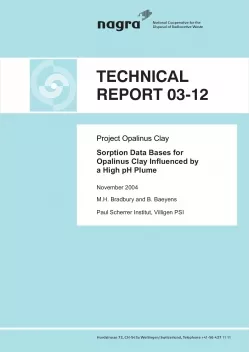
Technical Report NTB 03-12
Sorption Data Bases for Opalinus Clay Influencedby a High pH Plume
The interaction of groundwater with the large quantities of cement/concrete used in the construction and backfilling of emplacement tunnels containing long-lived intermediate level radioactive waste may give rise to the release of a pulse of hyperalkaline fluid (pH plume) into the surrounding rock. Since the pH of this plume could remain in excess of 12.5 for tens of thousands of years, many minerals in a sedimentary host rock would be unstable leading to dissolution reactions, secondary mineral precipitation and changes in groundwater chemistry.
An Opalinus clay formation in the Zürcher Weinland, is under consideration by Nagra as a potential host rock for a repository of spent fuel (SF), vitrified high-level waste (HLW) from reprocessing of spent fuel and long-lived intermediate-level radioactive waste (ILW). The purpose of this report is to assess the effects of the interactions between a pH plume and Opalinus clay on the sorption properties of the formation and to provide appropriate sorption data bases.
